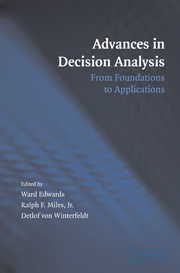Book contents
- Frontmatter
- Contents
- List of Contributors
- Preface
- 1 Introduction
- PART I HISTORY AND FOUNDATIONS OF DECISION ANALYSIS
- PART II STRUCTURING DECISION PROBLEMS
- PART III PROBABILITIES AND BAYES NETS
- 8 Eliciting Probabilities from Experts
- 9 Aggregating Probability Distributions
- 10 Model Building with Belief Networks and Influence Diagrams
- 11 A Bayesian Approach to Learning Causal Networks
- PART IV UTILITIES
- PART V RISK ANALYSIS
- PART VI DECISION ANALYSIS IN A BEHAVIORAL AND ORGANIZATIONAL CONTEXT
- PART VII APPLICATIONS OF DECISION ANALYSIS
- Index
- References
10 - Model Building with Belief Networks and Influence Diagrams
Published online by Cambridge University Press: 05 June 2012
- Frontmatter
- Contents
- List of Contributors
- Preface
- 1 Introduction
- PART I HISTORY AND FOUNDATIONS OF DECISION ANALYSIS
- PART II STRUCTURING DECISION PROBLEMS
- PART III PROBABILITIES AND BAYES NETS
- 8 Eliciting Probabilities from Experts
- 9 Aggregating Probability Distributions
- 10 Model Building with Belief Networks and Influence Diagrams
- 11 A Bayesian Approach to Learning Causal Networks
- PART IV UTILITIES
- PART V RISK ANALYSIS
- PART VI DECISION ANALYSIS IN A BEHAVIORAL AND ORGANIZATIONAL CONTEXT
- PART VII APPLICATIONS OF DECISION ANALYSIS
- Index
- References
Summary
ABSTRACT. Belief networks and influence diagrams use directed graphs to represent models for probabilistic reasoning and decision making under uncertainty. They have proven to be effective at facilitating communication with decision makers and with computers. Many of the important relationships among uncertainties, decisions, and values can be captured in the structure of these diagrams, explicitly revealing irrelevance and the flow of information. We explore a variety of examples illustrating some of these basic structures, along with an algorithm that efficiently analyzes their model structure. We also show how algorithms based on these structures can be used to resolve inference queries and determine the optimal policies for decisions.
We have all learned how to translate models, as we prefer to think of them, into arcane representations that our computers can understand, or to simplify away key subtleties for the benefit of clients or students. Thus it has been an immense pleasure to work with graphical models where the representation is natural for the novice, convenient for computation, and yet powerful enough to convey difficult concepts among analysts and researchers.
The graphical representations of belief networks and influence diagrams enable us to capture important relationships at the structural level of the graph where it easiest for people to see them and for algorithms to exploit them. Although the diagrams lend themselves to communication, there remains the challenge of synthesis, and building graphical models is still a challenging art.
- Type
- Chapter
- Information
- Advances in Decision AnalysisFrom Foundations to Applications, pp. 177 - 201Publisher: Cambridge University PressPrint publication year: 2007
References
- 9
- Cited by



